Abstract
The government of the United Kingdom has continually implemented the use of CCTV surveillance cameras as an instrument to deter crimes, maintain peace and order, and solve crimes. With more than four million such cameras installed throughout the country, they capture almost every movement and activity of individuals plying public spaces. Capturing and storage of information impinge upon the privacy and personal freedom of individuals. This study aims to determine how CCTV surveillance impacts crime reduction, Newham residents’ views on CCTV surveillance, the views of law enforcers and operators on CCTV surveillance and its effectiveness in crime reduction, and the technology used. The constructivist theoretical perspective served as the framework in analyzing CCTV technology and society. CCTV surveillance cannot effectively reduce crime despite the huge amount of money poured into the system. But it cannot be eliminated as a crime intervention because it will only result to havoc and more criminality in society. Social groups then have to intervene in the implementation of the program so that abuses by those who hold the authority will not abuse the immense power of surveillance wields against the populace.
Introduction
CCTV surveillance cameras are prevalent in the United Kingdom as part of the government’s effort to curb terrorism and criminal acts. There are an estimated 4.2 million CCTV cameras installed at every corner, with one camera eyeing 14 individuals (Tyler 2006; How we are 2006). This can be translated to about 300 cameras that may capture a person in a single day (Tyler 2006; How we are 2006). Government agencies, both local and national, security services, the police, as well as private entities operate the numerous CCTV systems in UK surveilling public utilities, airports, railway stations, hospitals, schools, etc. (Tyler 2006). This activity causes concerns among scholars and civic groups because it erodes democratic rights and intrudes upon the privacy of individuals (Tyler 2006).
With a large amount of money poured into the CCTV infrastructure and operation and negative social and political repercussions, would it be worth pursuing this program in the light of the reduction of crime in United Kingdom. This study will explore the effectiveness of CCTV surveillance cameras in the reduction of crime in Newham, a borough of London. Personal sentiments and opinions of the residents on the program were elicited through the use of survey interviews. On the side of the government, law enforcers and CCTV operators were interviewed to get their perception, views and experiences on crime reduction as a result of CCTV surveillance.
The CCTV technology will likewise be described in the paper, the onset of CCTV use, the developments in the technology, and future technology that will be integrated into CCTV surveillance. Equally important is the movement of social groups (e.g. Privacy International) to temper the effect of society-wide surveillance through enforcement of laws that would protect individuals’ liberties and freedoms. The current laws governing the privacy of individuals and institutions and government agencies entrusted to carry out this mandate will be discussed in this paper.
The area chosen for this study is the community of Newham which is located three miles east of the city and north of River Thames (About Newham n.d.; Maps and Travel n.d.). Its population of 243,891 in 2001 consisted of 119,872 males and 124,019 females (Census 2001), with the highest proportion of non-white inhabitants composed of a mixture of Chinese, Black, other Asians and another ethnicity (Newham in the Census n.d.). Its mid-2005 population is 246,200 (Office for National Statistics, cited in 2005 mid-year 2006) while the estimated population for 2006 is 248,400 with 6,858 inhabitants per square kilometer (London Borough n.d.). Its current population is estimated to be 250,000 inhabitants (Newham Council n.d.). While several studies (e.g. Newcastle upon Tyne city center, Birmingham city center, King’s Lynn city center, Airdrie town center, Glasgow, underground stations in London, etc.) were made in other locations in the United Kingdom, no research is conducted in Newham.
In order to gain insight on the views and feelings of residents based in demographic data, analysis takes into consideration the age groups or respondents, are they citizens or immigrants, length in residency in Newham, etc. Temporary tourists are excluded from the study because their stay in the community lasts for only a short duration.
The findings of this study will be a contribution to the continuing debate on the effectiveness of CCTV surveillance in crime reduction and providing a safe environment for the people. Thus, law enforcement officers, the Newham council, civic groups concerned with the advocacy of personal and civil rights, academic circles and scholars and interested residents can benefit from this study. In general, this paper is an invaluable contribution to the exploration of the field of study in crime reduction using CCTV technology and how the Newham community and residents perceived such program. The perception of residents who are the subject of surveillance plays a role in the success of a program and the technology itself.
Aim
The primary purpose of this paper is to assess and review the impact of CCTV surveillance cameras in crime reduction and deterring the commission of the same in the London borough of Newham.
Objectives and Research Questions
This paper would like to address four main research questions:
- Is CCTV surveillance technology an effective intervention in crime reduction?
- What is the technology applied or used in CCTV surveillance?
- What are the rules and regulations governing the use of CCTV and related technology in the United Kingdom in general and Newham borough in particular?
- Do the residents of Newham as members of society benefited physically or psychologically from the implementation of CCTV surveillance?
To attain the primary purpose of this study and answer the research questions, the following objectives will guide the research:
- to describe the technology used in CCTV surveillance;
- to know Newham residents’ views and sentiments towards CCTV surveillance;
- to know the positive and negative effects of CCTV surveillance;
- to determine from statistical data the effectiveness of CCTV surveillance in curbing crime;
- to know the laws and regulations the government surveillance and storage of personal information.
Literature Review
Overview of CCTV Surveillance
CCTV surveillance is an outgrowth of information technology that incorporates various technologies to make efficient use of information. Since information technology refers to the application of various technological devices that includes even washing machines and video recorders (Burton 1992), many writers suggest restriction of the term to the management and application of information whether in the “administration, government, education, etc.” (Burton 1992, p. 1). Information technology can be used in arriving at effective decisions and control of resources (Roche & Blaine 1996). Information technology does not exist in a vacuum as computers interact with “men and machines… and associated social, economic and cultural matters” (Burton 1992, p. 2).
According to Clarke (1897), surveillance is “one of the elements of tyranny” and connotes espionage, “repression of individuals, and suppression of ideas” but essential in monitoring some types of activities and individuals, terrorist suspects or perpetrators of syndicated drastic crimes (para. 4). Surveillance involves organized “investigation or monitoring of the actions or communications of one or more persons” (Clarke 1987, para. 10). Its foremost objective is to gather data on persons and their activities as well as those with whom they interact, and a secondary objective of deterring people from committing some acts (Clarke 1987). “Dataveillance” is coined to describe surveillance of an individual’s activities through the use of electronic data (Tyler 2006, para. 28). Clarke (1987) added dataveillance involves “systematic monitoring of people’s actions or communications” (para. 1 ). It is “computer-based” and utilizes all available technology as well as future developments (para. 24). Corporations use dataveillance on a personal level (called personal dataveillance) on their applicants (Clarke 1987). Dataveillance can also be applied to groups or members in society to identify individuals that would be targeted to personal dataveillance) (Clarke 1987).
According to Clarke (1987), dataveillance creates a: “climate of suspicion, adversarial relationships, the focus of law enforcement on easily detectable and provable offenses, inequitable application of the law, decreased respect for the law and law enforcers, reduction in the meaningfulness of individual actions, reduction in self-reliance and self-determination, stultification of originality, increased tendency to opt-out of the official level of society, weakening of society’s moral fiber and cohesion, destabilization of the strategic balance of power, and repressive potential for a totalitarian government” (para. 67).
Remarkable advantages dataveillance provides includes security and protection of people from bodily harm, protection to property, financial advantage arising from “detection and prevention of various forms of error, abuse, and fraud”, advantage by the government in taxation and delivery of social welfare, and profit by private entities in finance and insurance (Clarke 1987). Mass dataveillance is arbitrary and poses more danger on each individual because there is no suspect beforehand but can be justified in the name of national security (Clarke 1987).
Process and Technological Development in CCTV Surveillance
The advent of silicon chips, also called microchips, in the 1960s altered the way from which information is processed (Carter 1993). Information technology (IT) allowed the storage of huge information that can be retrieved selectively (Carter 1993). According to Carter (1993), handling of any information, whether audio, video, data, or image, follows four operations, namely: a) capturing, b) processing, c) storage and retrieval, and d) communication.
Information technology, as defined by Carter (1993, p. 8), “is the use of modern technology to aid the capture, processing, storage and retrieval, and communication of information, whether in the form of numerical data, text, sound or image.” Digitalization is “based on counting numerical digits” (Carter 1993, p. 11) whereby information travels by pulses of electron particles in contrast to the analog that uses waves to transmit electrical information (Carter 1993).
CCTV technology is an integration of several technologies that includes the camera, computer software, monitors, interconnection, etc. The government continually integrates newer technological developments into the system to enhance efficiency. The primary process involved in all IT devices are the same, such as: capturing, processing, storage and retrieval and communication (Carter 1993). Capturing or data collection video recording equipment such as video cameras gathers information in real-time. The video cameras are positioned are different areas in the same location to capture images from various angles. The equipment must be weather-proof for protection against the elements and the cameras are mounted on high platforms or buildings to evade human vandalism. Surveillance cameras equipped with infrared allow high-resolution capturing of images even at nighttime.
Captured images are transmitted to central control rooms via cable or satellite. Fiber optic cables allow fast transmission of vast information within seconds. The information is then processed and stored in a computer storage system through the use of software applications or platforms that allow storage of images in digital format. The images are processed by the software and converted into digital information or images. Under the current technology, data are saved into computer servers located at secure locations for retrieval when needed. Communication refers to the transfer of the data to the end-user through some medium (e.g. CD-ROM) (Carter 1993) who may be an individual, government agency or the court when used for prosecution.
The CCTV system during the 1960s had one monitor per camera, interconnected by a coaxial cable and with “very low resolution black and white cameras connected” (Beagle 2008, para. 3). The addition of “switch boxes” allowed the operator to transfer viewing from one camera to another, which means that one monitor can view several cameras although not simultaneously (Beagle 2008). During the 1970s, the advent of “multiplexers” enabled images from several cameras to be viewed on the same screen through “multiple frames” (Beagle 2008, para. 4).
Emerging with the multiplexer in the 1970s are the video cassette recorders (VCRs) that eased out recording and solid-state cameras that facilitated the “reliability and the integration of VCRs” (Beagle 2008, para. 4). Images from the VCR system are “grainy and unclear” and cannot be conclusively used for recognition while concurrent viewing and recording are not possible (Beagle 2008, para. 6). The digital video recorders (DVRs), being computer-based, that emerged in the middle of the 1990s eliminated the early recording and image deficiencies (Beagle 2008). DVR can function without the intervention of a human operator (Beagle 2008). The earlier recording was made through the use of individual and isolated VCRs. Later, each camera is linked to a central control room that records all images.
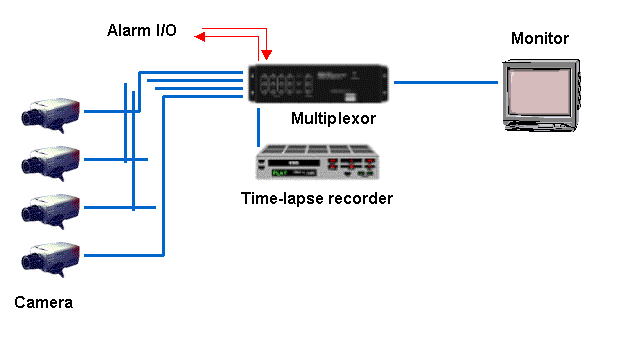
Recording under the analog CCTV uses a video cassette recorder (VCR) (Converting an analog n.d.). This system requires much maintenance, cannot be accessed at a distance and is usually not compatible with other technologies (Converting an analog n.d.). The time-lapse video recorders require frequent changing of tapes and produce low-quality images (Converting an analog n.d.). With digital video recorder (DVR) technology, the operator does not have to intervene in the storage process while quality is maintained despite a lapse of time (Converting an analog n.d.).
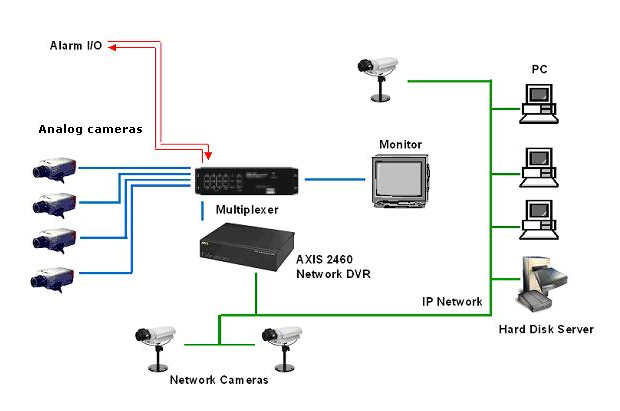
The introduction of new technologies and devices (e.g. software, IP network, see Figure 2) allowed interconnectivity of analog cameras with digital technology. The IP-Surveillance system allows interconnection of the analog camera with the network (e.g. video server) and storage of images into the network server (Converting an analog n.d.). Storage is served by the computer system (e.g. hard disc server) (Converting an analog n.d.) and DVR. Using IP technology with DVR, remote viewing, two-way audio transmission, and camera control is possible through the internet, local area network or wide area network (Beagle 2008).
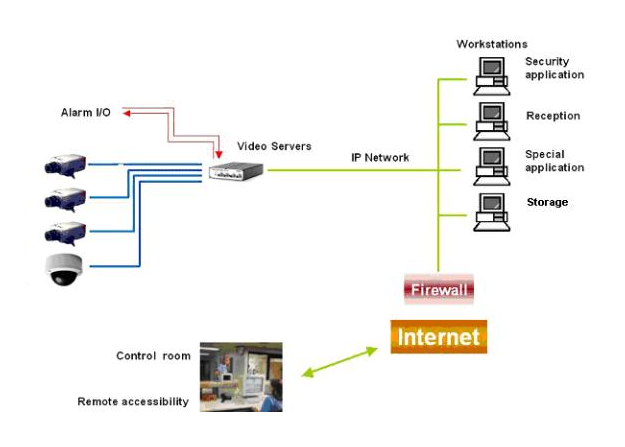
Upgrading of the analog system to digital setup does not mean discarding of all analog devices since integration is possible (Converting an analog n.d.). Figure 3 refers to the first level upgrade that can provide all the benefits of digital technology such as remote access, password protection, accommodating integration with other technologies and applications, lower cost, and compatibility with future developments (Converting an analog n.d.). The interconnection between the analog systems and the network is made possible by the introduction of the video server as shown if Figure 3 (Converting an analog n.d.).
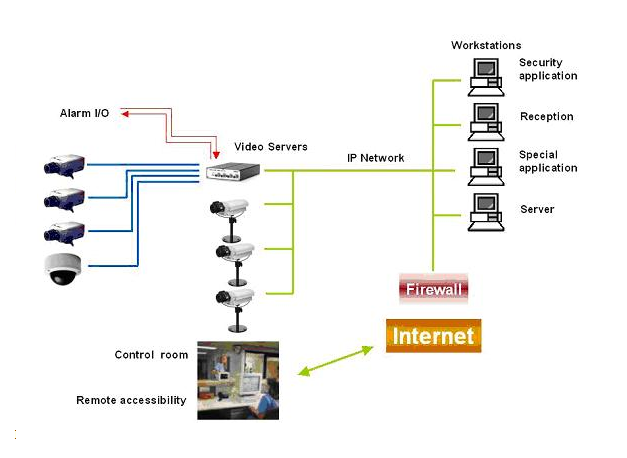
According to Axis Communications, the IP-Surveillance system is an option to DVR with its “high-performance, low-cost digital video surveillance and monitoring” (Converting an analog n.d., para. 2). The combination of the digital system with IP-surveillance provide concurrent recording and playback, maintaining quality images, high capacity or unlimited storage, accessibility at the distance, can be accessed by any authorized personnel (e.g. police, individuals granted with passwords), low maintenance cost in the long run, etc. (Converting an analog n.d.). Going beyond the first-level upgrade allows attachment of additional cameras to the network without the need of coaxial cables analog cameras require, more functionalities, and viewing through the web browser via the computer monitor (Converting an analog n.d.).
The onset of CCTV Surveillance
Government spending from 1999 to 2001 accounts for £170 million in CCTV surveillance at “town and city centers, car parks, crime hot spots and residential areas” (Home Office Policing and Reducing Crime Unit, 2001, p. 8, cited in Welsh & Farrington 2002, p. 54). The Home Office spent 78 percent of its crime prevention budget in the 1990s on the installation of the surveillance system (Tyler 2006) and around 75 percent from 1996 to 1998 (Koch 1998, cited in Welsh & Farrington 2002). Around £500 million was spent during the last ten years for the installation of the CCTV system alone (How we are 2006; Tyler 2006). According to Privacy International, around £150 to £300 million was spent annually on CCTV surveillance (reckoned in 1995 with only 200,000 cameras then) (Statement 1995).
Limited use of CCTV surveillance started in 1953 during the occasion of the Queen’s coronation and became a permanent fixture in the 1960s (How we are 2006). CCTV cameras were first used on car plate numbers by the IRA to locate suspects in London and later utilized to monitor speed and traffic enforcement (How we are 2006). Through digitalization, CCTV cameras capacitated to recognize faces and search for suspects (How we are 2006), called “smart CCTV”, combined video surveillance and facial recognition tools that identify “faceprints based on facial geometry” (Rogerson 2002, para. 1, 2). According to Visionics Corporation, smart CCTV can search a million “faceprints” in a second with a possibility of error below one percent (Rogerson 2002, para. 2).
Digitalization CCTV equipment made UK in the first place that captures all movements of vehicles (Tyler 2006). The Automatic Number Plate Recognition (ANPR) database (created after conversion of CCTV cameras to read plate numbers) records 35 million plates per day, storing the destination of the driver, with the date and time (Tyler 2006). The CCTV system with facial recognition and vehicle monitoring is linked to an ID system, enabling the government to know the location of any person in any given time (Tyler 2006). Former Prime Minister Tony Blair, the Telegraph cited, supported this ID card system “to secure our borders and ease modern life” (Tyler 2006, para. 29).
In Newham, Philip Brey (University of Twente, Netherlands), said that smart CCTV has been in place in public areas as early as 1998 (Rogerson 2002). More than 240 cameras are deployed from point to point and troubled areas (Underhill 2000). The Newham system was interconnected in 2001 to the main control room handled by the Metropolitan Police Force of London (Rogerson 2002). The borough targeted a 10 percent crime reduction within six months following the pilot testing of the project, the Computer Weekly reported on 13 October 1998 (Rogerson 2002). The Weekly added that this is the first enforcement of the Newham council concerning technology (Rogerson 2002). Bob Lack (Emergency Services Manager, Newham) foresees that around “250 councils in the CCTV user group” would be using the technology, Computer Weekly said (Rogerson 2002, para. 6). The report of Surveillance Studies Network (an academic group) published by Britain’s Information Commissioner Richard Thomas revealed the coming years will see increased monitoring by both the public authorities (e.g. government agencies and institutions) and private sectors (e.g. employers, corporations) (Tyler 2006).
Ethical and Civil Concerns
UK is the leads the world in using invasive surveillance that includes “biometrics, surveillance cameras, computer databases, and DNA testing” (PHR2206 2007, para. 4). Invasive surveillance connotes intrusion into the privacy and the personal lives of the people and violation of their rights and civil liberties. The use of CCTV surveillance system as an intervention program in crime reduction presents several issues and concerns.
The violation of privacy and liberties are connected to the storage and use of the information captured and stored by the government on individuals. Carter (1993) mentioned that in all countries, the maintenance of public records clashed with the tenets upholding individual freedom which is aggravated by the increasing sophistication of information processing available at the disposal of the government (Carter 1993). Such sophistication includes the retrieval of data of individuals from government and private databanks, monitoring of movement and travel of persons, and recognition and tracking of vehicles (Carter 1993). Capturing and retention of innocent activities (e.g. shopping, going to work) presents a worrisome scenario (Bowcott 2008). More laws should be passed to ensure the protection of the information gathered since even the government itself promotes greater distribution of data among public agencies to facilitate governance (PHR2206 2007). Personal information held by public authorities was reported by the Information Commissioner in two 2006 articles to be sold by police officers to private detectives in exchange for cash (PHR2206 2007).
Newham’s legislated support and use of smart CCTV was criticized by Assistant Data Protection Registrar, Jonathan Bamford because the system equates individuals with convicted criminals and transgresses the civil freedoms of individuals, the Computer Weekly mentioned (Rogerson 2002). Besides the ethical repercussion that would ensue from the use of smart CCTV, Philip Brey (University of Twente, Netherlands) cautioned on the need to balance national security versus civil freedoms, know the technology’s “power and reliability”, and prospects for use and abuse (para. 9).
Information Commissioner Richard Thomas acknowledges the vital role of having CCTV database in crime detection and prevention but suggested the laying of adequate safeguards so that captured images shall be used only in discovering the crime, and that storage must be secured, providing access only to persons duly authorized (Bowcott 2008).
Rogerson (2002) reiterated the incidents with ethical repercussions identified by Philip Brey arising from CCTV surveillance as follows: a) error (wrongful matching that might harass innocent persons, can be avoided by use of extreme care), b) the “(f)unction creep” wherein identification extends beyond suspects and criminals to other functions (e.g. inclusion of “faceprint database” from drivers’ license, “analysis of crowd behavior”), a usual occurrence with the emergence of a new technology that cannot be covered by regulation (para. 11), and c) violation of privacy which is a natural result of any surveillance program, capturing the face which is a “highly personal aspect of one’s body” by which one is identified dehumanizes a person because facial features are converted into information (as small as an 88-byte file) (para. 12).
Brey pointed out that despite the social advantage CCTV offers, it should not lessen the freedom of individuals (Rogerson 2002). “Faceprints” belong to the “electronic persona” of all persons and should be regarded as such by technological engineers (Rogerson 2002, para. 13). Brey supported the identification of possible occurrences of “function creep” by inventors and end-users of the technology, and undertake necessary safety nets to counter its objectionable manifestations (Rogerson 2002, para. 11).
Reduction and Displacement of Crime
The government invested millions on the CCTV program with no considerable impact of crime reduction (Bowcott 2008) as reflected in several studies conducted to determine its impact. It is engaged in active promotion of the program through the grant of funding support to local governments that embark on the CCTV project (Statement 1995). The generally no remarkable decrease in crime rates was confirmed by the Home Office research, describing the turnout as “little overall effect on crime levels” (Tyler 2006 para. 8). Other research made by academic scholars showed a reduction in crime in monitored areas but it jumped up in nearby places with no such monitoring system (Tyler 2006). Intelligence reports indicated that numerous high-profile criminals moved their operations as a result of face-recognizing cameras (Underhill 2000). Bob Lack, in charge of Newham security operation (former police officer), expressed satisfaction over the lower crime rates in the borough “(f)or the first time in 15 year” and “lower than in the rest of London” (Underhill 2000, para. 1).
From October to December 1998, the Newham Crime and Disorder Partnership authorized the Safe Neighbourhoods Unit (SNU) to conduct three surveys to elicit residents’ and businesses’ views and experience on crime, with particular focus on robbery and street crimes in the hope of finding solutions to local problems (The London Borough n.d.). The surveys (consisting of a household interview survey on residents, a self-completion survey on businessmen and a self-completion survey of secondary school students) were administered in Canning Town and Green Street SRB at Newham (The London Borough n.d.).
In Canning Town, aside from crimes involving motor vehicles, the crime rate falls in average for the 12-month survey period while robbery and snatching theft rates are nearly similar to that of the London average (The London Borough n.d.). For the same period, the Green Street area produced a high crime rate with 13 percent (of respondents) of burglary (almost double the national average) and 5.3 percent of automobile theft (more than twice the London average) (The London Borough n.d.). Demographic statistics revealed that women victims of robbery and snatch theft comprised of 10.1 percent (more than four times to that of London average); perpetrators of crimes against person consist of males (92 percent), under 25 years of age (75 percent), white (55 percent), and unknown to victims (85 percent); and victims of crimes against the person are women (55 percent), below 45 years of age (74 percent), and black or Asian (67 percent) (The London Borough n.d.).
The Home Office gathers yearly crime statistics (per 1,000 population) for all regions and areas in UK through the British Crime Survey (BCS) for overall crime levels, burglary, robbery, sexual offenses, overall vehicle crime and violence against the person (Crime 2008). For Newham Borough, there is a decrease of 9.6 percent from 2003 to 2008 in total crime rates while London has a decrease of 19.1 percent for the same period (Crime 2008). But for the 2006-2007 data compared 2007-2008 period, Newham has an increase of 0.9 percent while London has a decrease of 6.2 percent for overall crime rates (Crime 2008). The lowest annual rate for the same period of 2003 to 2008 in Newham is 87.1 percent (2004-2005) while London has 64.7 percent (2007-2008) (Crime 2008).
Table 1. Comparative Overall Crime Level: London and Newham. Source: Home Office – British Crime Survey (BCS) (Accessed from Crime: FTI Indicators 2008, Selected Area: Newham LB 2008).
Graph I illustrates the overall crime level in Newham and London. Newham had higher crime statistics than London and while the latter’s crime rate continually decline, Newham’s statistics increased twice (from 2004-2005 to 2005-2006; from 2006-2007 to 2007-2008). This is significant because while the general trend in crime statistics of London is declining, Newham as its borough had an increasing crime rate.
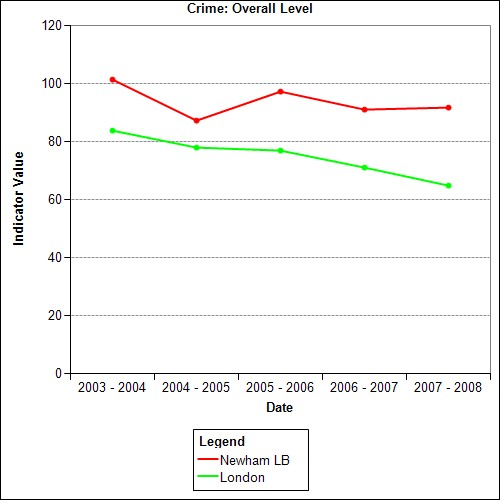
Detective Chief Inspector Mick Neville, Officer-in-Charge of London Metropolitan police commented that officers need training on the technology (Bowcott 2008). Moreover, police officers would not go beyond inquiring with the city councils whether specific street occurrences were monitored (Bowcott 2008).
Although statistics showed a poor crime resolution, the government still believes that CCTV surveillance will achieve its purpose. Data showed that despite UK’s use of surveillance cameras exceed more than any country in Europe, a mere three (3 %) percent of robberies committed in the streets of London was resolved through the use of surveillance technology (Bowcott 2008).
On other crimes committed in Newham (e.g. burglary, robbery, sexual offenses, vehicle crime, violence against persons), its overall statistics reflected the lowest margin of 0.2 percent to a maximum 12 percent higher than the London statistics for the said crimes from 2003 to 2008 (See Tables 2 to 6 and Graphs 2 to 6).
Table 2. Comparative Data on Burglary Level: London and Newham. Source: Home Office – British Crime Survey (BCS) (Accessed from Crime 2008).
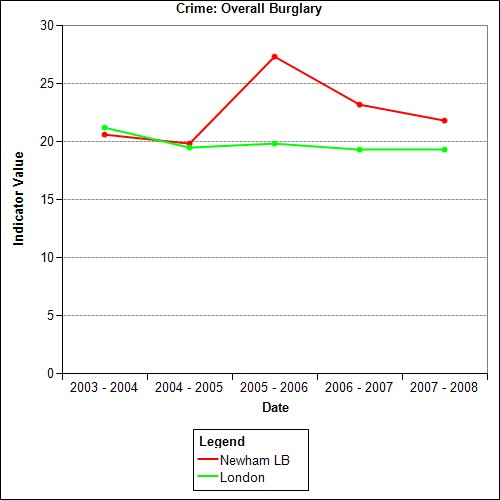
Table 3. Comparative Data on Robbery: London and Newham. Source: Home Office – British Crime Survey (BCS) (Accessed from Crime 2008).
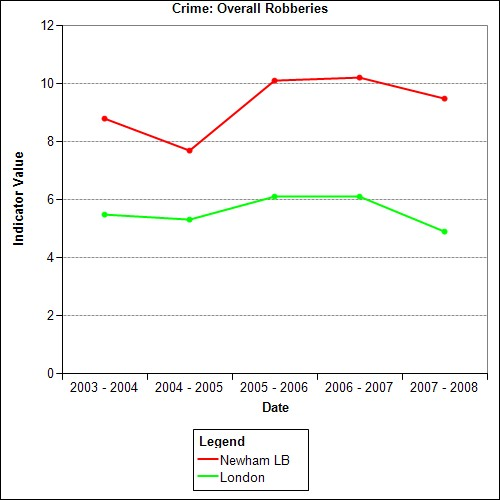
Table 4. Comparative Data on Sexual Offences: London and Newham. Source: Home Office – British Crime Survey (BCS) (Accessed from Crime 2008).
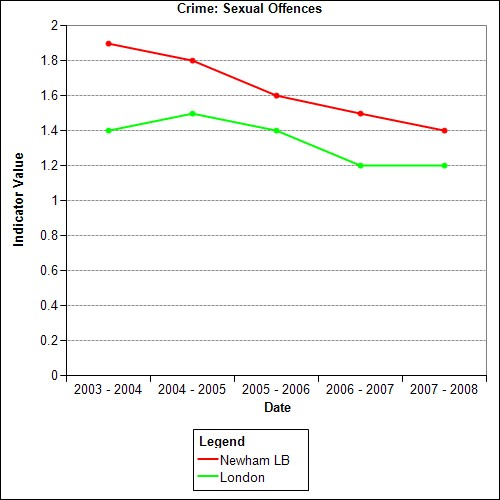
Graph 4. Newham and London Overall Sexual Offences Level. Source: Newham Information Management System (Accessed from Crime 2008).
Table 5. Comparative Data on Vehicle Crime: London and Newham. Source: Home Office – British Crime Survey (BCS) (Accessed from Crime 2008).
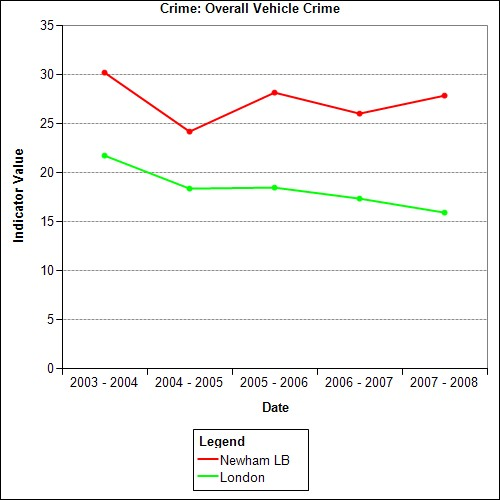
Table 6. Violence Against The Person. Source: Home Office – British Crime Survey (BCS) (Accessed from Crime 2008).
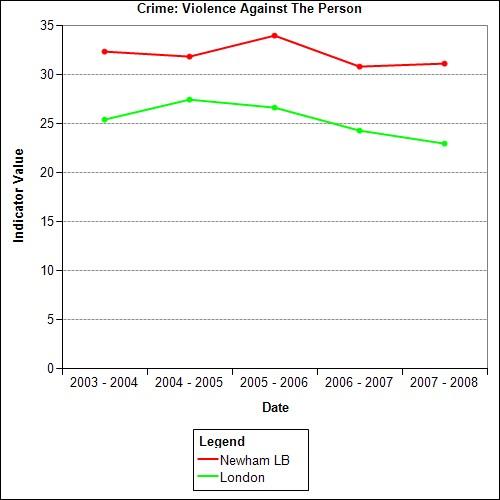
Graph 6. Overall Violence Against Person: Newham and London. Source: Newham Information Management System (Accessed from Crime 2008).
Positive Impact of CCTV Surveillance
Despite the setback in the use of CCTV systems to curb crime, there are some recognized benefits from its use. According to Brown (1995), “the police actively use CCTV systems for gathering information” (p. 6). The cameras afford covert surveillance to high crime areas just like police officers (Brown 1995). The data gathered are utilized by police officers in planning synchronized response and to further pursue direct inquiry, as well as determination of “false alarms” that require no police action, thus, avoiding unnecessary wastage of police assets (Brown 1995). CCTV surveillance is usually used in handling “anti-social and criminal behaviors” that include nuisance behavior, assault and wounding but it has also caused apprehensions in “burglary, car crime, robbery and murder” (Brown 1995, p. 6). Brown (1995) said that the initial installation of surveillance cameras in a particular location served as a powerful restraint on varied types of crimes as reflected in the case studies in city centers of Newcastle, Birmingham and King’s Lynn. Since such impact may not be sustained for a long time, it is necessary to use the cameras “to increase the risk of arrest for offenders” (Brown 1995, p. 7).
In the Birmingham city center where the coverage of cameras was “relatively low”, the crimes of robbery and theft against persons were restrained and lessened in areas having satisfactory coverage of cameras (Brown 1995, p. 7). This may also be an indication of displacement of crimes to locations without cameras (Brown 1995).
Under the meta-analysis, five studies showed no impact upon violent crimes but eight showed remarkable positive impact upon vehicle crimes (Welsh & Farrington 2002). Five studies in UK under the city center and public housing settings revealed a minute remarkable impact with three of them desirable and two, undesirable (Welsh & Farrington 2002). Only one study by Skinns (1998a, cited by Welsh & Farrington 2002) out of 22 types of research made a cost and benefit analysis, that Welsh & Farrington (2002) cannot make a sufficient evaluation of. But Skinns (1998b, cited in Welsh & Farrington 2002) stated that savings from fewer prosecutions exceed by three times against the expenditure in the operation of CCTV.
Enhancing Efficiency
The head of Visual Images, Identifications and Detections Office (VIIDO), New Scotland Yard said that an additional initiative to increase conviction would incorporate the creation of a national CCTV database that includes photographs of convicted criminals and unknown suspects, although the technology is still in the refinement stage (Bowcott 2008).
Besides the pan/tilt/zoom and infrared capacity of the cameras, they are also equipped with motion detectors, bulletproof casing, alert system, and “automated self defense mechanisms” (Statement 1995, para. 4). Evidence shows that the program is “less effective than was first imagined and that the impact on crime is patchy” (Statement 1995, para. 10).
The latest CCTV technology created by researchers enables police officers to follow individuals even as they change clothing or appearance or move through the mass of people (Johnson 2007). According to BAE Systems’ project manager, Andrew Cooke, “a small, highly-trained team” makes the surveillance system effective (Johnson 2007, para. 4). Using automation, one operative can follow several persons at a time more accurately, Cooke added (Johnson 2007). As part of the European Commission initiative which provided the initial funding before the London bombing, the Integrated Surveillance of Crowded Areas for Public Security (Iscaps) project will be implemented throughout Europe (Johnson 2007).
Lately, Newham opted to migrate to utilize internet-based “IP Video technology” by IndigoVision in preparation for a complete “IP-CCTV solution” (Newham borough 2008, para. 1). This system would enhance the management of the environment and guarantee the safety of the public (Newham borough 2008). The current recording of CCTV images is uses VCR (Newham borough 2008). Initially, 200 cameras in North Woolrich will undergo VCR replacement and will be interconnected through the Network Video Recorders (NVRs) (Newham borough 2008). Newham’s recording system of more than 800 cameras will ultimately be replaced as funds become available (Newham borough 2008). Gary Hobbs, Newham Council’s Principal Electrical Services Engineer, said that such decision resulted from the technology’s qualities that include “flexibility of configuration, particularly with multi-casting, superior image quality, analytics and compression technology,” as well as the company’s assurance to provide technical support and development in the future (Newham borough 2008, para. 3). IP Video functions with the current analog system and the future total digital system (Newham borough 2008). Images recorded from the 10 “fault-tolerant standalone NVRs” installed at Queensland House are viewed at the control room in Folkestone Road (Newham borough 2008, para. 4).
Viewing CCTV surveillance as a police “incident response” tool instead of a “crime prevention tool” (Squires, 2000, p. 5), Norris and Armstrong (1999, cited in Squires 2000) mentioned that out of 600 observation hours, police officers were deployed only 45 times, clearly indicating that CCTV monitoring has not caused “regular incident response” (p. 5).
At the forefront against the use of CCTV surveillance in crime reduction is Privacy International. It calls upon the British government on the restriction on the application of CCTV technology (e.g. Computerised Face Recognition or CFR systems, Forward-Looking Infra-red Radar or FLIR systems that can see beyond walls and total darkness, miniature surveillance devices) and enactment of necessary legislation (Statement 1995). Privacy International proposes the implementation of reforms such as: the imposition of minimum standards of training and criteria for operators, the proscription of the “sale and transfer of images from the systems,” and “direct oversight by parliament” (Statement 1995, para. 18).
The implications of the Birmingham study on the sound practice in CCTV use are as follows: a) total integration of the system with the “police command and control strategies” that would help in taking decisions and dispatch of policemen and coordinated action, b) increase in coverage to manage crime more efficiently by using cameras that can pan, tilt or zoom to enhance such coverage, as well as placement of cameras where no obstruction stands, c) ensure that crimes against persons are not simply displaced to adjacent areas where coverage is poor, and d) sufficient publication of CCTV success incidents to “reduce fear of crime and to help deter offenders” (Brown 1995, p. 8).
Laws, Policies and Regulations Governing CCTV Surveillance
Law of Confidence – Early Basis of Rights to the Privacy
United Kingdom has no written constitution. Political parties push for one that would embody the bill of rights (PHR2206 2007). The European Convention on Human Rights (ECHR) and right to privacy were incorporated in a limited manner into domestic law through the Human Rights Act (HRA) which took effect on October 2, 2000, (PHR2206 2007). The right to privacy slowly evolved in case of laws based on the “law of confidence” utilised since 1849, providing protection against any unauthorized release of personal data (PHR2206 2007, para. 2). Britain has no general tort law on violation of privacy and UK is not required by the ECHR to enact such law (Wainwright & another v. Home Office 2003) (PHR2206 2007). In May 2005, however, in congruence with the ECHR case on Princess Caroline, the Court of Appeals decided in Douglas v. Hello (2005) that States are obliged to protect the privacy of individuals against invasion and which the court must enforce (PHR2206 2007).
Data Protection Act and Freedom from Information Act
Protection of privacy and personal information involves the storage and retrieval of such information. The European Commission had laid out the guidelines that would ensure protectio of individual freedoms on storage and retrieval of data (Carter 1993). The Data Protection Act 1984 addressed the increasing risk of abuse afforded by “computing equipment” that stores huge data,, allows data manipulation at extreme speed, and access of data even outside of the storage facility (Carter 1993, p. 247). The primary safeguards provided by the Act are as follows: a) registration of all government and private entities that store data with the Data Registrar, b) providing the purpose of storage, c) proscription against use of data for any purpose other than the those indicated, d) non-disclosure of the information to other entities, and e) allowing an individual to request a copy of the information held by the organisation (Carter 1993).
The Data Protection Act of 1984 was replaced by the Data Protection Act of 1998 (approved in July 1998, took effect on 1 March 2000) (PHR2206 2007). The new law implemented the European Data Protection Directive enumerating the eight principles that delimit the use by the government and private organizations on the use of personal information collected (PHR2206 2007). The Act requires all entities maintaining personal data to register with the Information Commissioner (PHR2206 2007).
The government, however, undertook a contrary move. It pushes for greater latitude in the distribution of more data among public agencies in pursuance of “e-government, population registration and local government” (PHR2206 2007, para. 7). Thus, the Cabinet drafted the vision statement in September 2006 that allows sharing of data as the government deems it proper for the public interest (PHR2206 2007). Despite the wide criticism by civic groups and the opposition, the Information Commissioner approved of the move (PHR2206 2007). The Office of the Information Commissioner (ICO) is charged with the enforcement of the Data Protection Act of 1998 and the Freedom of Information Act 2000 (Tyler 2006). Its offices in Northern Ireland, Scotland and Wales (About the ICO n.d.) was able to register 276,000 databases as of 2006 (PHR2206 2007). The Freedom of Information Act 2000 also prescribes guidelines on access to information and rights of persons or entities to ask for needed information from public entities or companies under government authorities located in England, Wales, Northern Ireland and non-devolved entities in Scotland (Freedom of Information n.d). Grant of the requested information must subscribe to the guideline published by the ICO (Freedom of Information n.d). The ICO can take appropriate actions against government entities that fail to comply with its obligations under the Information Act (Freedom of Information n.d).
Under the Data Protection Act, individuals are given the right to be informed of whatever personal information about them is stored and that personal information is appropriately managed (The Basics n.d.). Agencies that process information are required by the statute to advise the ICO of their activities and unless they are exempt, failure to provide such notification shall constitute a criminal act (Notification n.d.). Notice to ICO shall include the data gathering process and details on the personal information collected, all of which are entered into the “Register of data controllers” (Notification n.d., para. 2). The Register of data controllers, which the public may access (Notification n.d.), is a listing of agencies that processes information and includes their names, addresses, and the process they follow in the processing of information (Register n.d.; Notification n.d.). Notification ensures transparency and informs individuals how personal data are processed by organizations (Notification n.d.).
Entities or agencies processing personal information must comply, as required by the Act, to the following principles: a) the information is fairly and lawfully processed, b) used for limited purposes, c) only information that is adequate and relevant information is taken and not excessive, d) must be accurate and updated, e) must be kept for a specific period, f) processed according to individual rights, g) must be secure, and h) not pass beyond territorial boundary without sufficient protection (The Basics n.d.). The Act likewise an individual the right to know all information is stored about him/her in the computer or hard copy (The Basics n.d.).
The development and implementation of technology move with an unprecedented pace that policy-makers failed to keep up through laws and policies (Burton 1992). With many groups retaining information on countless individuals, UK has issued limited legislation providing rights to persons that pertain to personal privacy and access to information (Burton 1992).
Social Construction and Technological Determinism of Surveillance Technology
All the future uses of technological artifacts created cannot be predicted at the time of their creation. However, the devices and their uses change with time. A particular private group, corporation or entity, or the government might push for the use and development of a technological device according to its agenda and program. In a corporation, the use of technology can displace workers if the production is automated. It may require additional studies to acquire the necessary skills to work with the device. While other devices or software applications succeeded and upgraded with several versions, some goes out of use and become obsolete. Thus, the success of technology and its devices are influenced by groups, users and society in general, referred to as social determinism by some scholars. This perspective is a response to technological determinism that espoused that technology has control and influence over the changes in society, and the latter and the end-users have no recourse but to accept the rules and standards of the technology (Burton 1992). Technological determinism, coined by sociologist and economist Thorstein Veblen (Ellul 1964; Jones 1990; Veblen n.d., cited in Chandler 2000), is a unilinear approach of ascribing change in society without a feedback mechanism. In this sense, society has no control over technology (Burton 1992). However, constructionists (advocates of SCOT) (Jackson, Poole, & Kuhn 2001) and constructivist scholars do not subscribe to determinism even in the sociological analysis of technology because it connotes predictability of the outcome of technology.
In technological determinism, when the CCTV surveillance technology is presented to society, the latter has no choice except to adopt or not use the technology (Burton 1992). CCTV surveillance will “bring about changes in the relevant society, and that the nature of those changes is inherent in the technology” (Burton 1992, p. 22). In this sense, technology drives society and the members can do nothing about it. Technology determines how members of society relate to each other. Once CCTV technology is given to the user by the producer, the social facets of research and development cannot interfere (Doyle 1997). The impact is inherent and established before whoever the user or for where the technology is used (Doyle 1997). Being autonomous of society (Doyle 1997; Chandler, 2000), it determines history, changes in society and social organizations, and overall societal transformation (Chandler, 2000). Thus, CCTV technology is viewed not as an invention of society but its vital component (Chandler, 2000). Assuming that the predetermined impact of CCTV technology is the effective monitoring and apprehension of offenders and suspected criminals, and reduction in crime rates, the impact would be different according to users and location. Its use in enclosed spaces by private companies with limited entrance and exit routes has more positive results than open spaces such as parking lots and other public spaces. Crime reduction also depends on the type of crime. Thus, the government use of CCTV surveillance in public spaces has a very low percentage turnout in reducing crime. At this point in time after several years of application, surveillance technology has not transformed society into a crime-free environment.
Under social determinism, society decides which technology to develop according to its priorities and values (Burton 1992). Technology emerges in a particular socio-cultural environment or setting and carries the values inherent in that environment or setting, Burton (1992) added. CCTV technology is used by the controlling group or organization to maintain the status quo or enhance the centralization of “power and control” (Burton 1992, p. 22). However, the contribution of various social forces and groups in the development of the product causes slow supplemental changes to earlier developments (Doyle 1997).
Social constructivism is a term substituted for social determinism to describe the phenomenon that the impact of a technological device cannot be predetermined. This sociological approach in studying science and technology (Brey 1997) traced its beginning in the middle of 1980s (Bijker, Hughes, & Pinch 1987, cited in Brey 1997). In a limited sense, social constructivism refers to the leading approach of Social Construction of Technology (SCOT) (Pinch & Bijker 1987; Bijker 1987; Collins 1985; Woolgar 1991, cited Brey 1997), and in a wider sense, includes the other approaches of social shaping (espoused by MacKenzie & Wajcman 1985a, 1985b; and MacKenzie, 1990), and the actor-network theory (espoused by Bruno Latour, Michel Callon, and John Law, and their followers) (Brey 1997).
Development in technology depends upon diverse factors and is beset by “technological controversies, disagreements, and difficulties” among various actors (capable of acting) or “relevant social groups” with similar ideological underpinnings and agenda (Brey 1997, para. 10). Technology is configured by actors and groups according to their plan to outdo competitors (Brey 1997, para. 10).
The three approaches to social constructivism are a) Social Construction of Technology (SCOT); b) Social Shaping of Technology (SST); and c) Actor-Network Theory (ANT). The “social constructivist” approach of social shaping focuses on the ambiguities in technological design and rationale for the success of one design over another (e.g. CPU vertical casing design and tower design) (Doyle 1997, para. 9).
Social shaping includes the process of “research and development, manufacture, marketing, and packaging,” and ultimately, consumer use (wherein the user may later reject the product for any other reason) (Doyle 1997, para. 12). Since the consumer or end-user uses the product according to one’s needs, there is no predetermination of the impact of technology (Doyle 1997). Sociologists of technology Williams and Edge (1996, p. 54, cited in Jackson, Poole, & Kuhn 2001) emphasised SST viewpoints deny the idea that technology arises from “a single social determinant, or through the unfolding of a predetermined technical logic” (p. 3). Actual studies made by Sproull and Keisler (1991) on the use of technology in organisations revealed the same conclusion that the resulting effect of using a technology cannot be known (Jackson, Poole, & Kuhn 2001). SST considers “choices” innate in the “design of individual artefacts and systems” in which choices send out different connotations “for society and for particular social groups” (Williams & Edge 1996, para. 7). Thus, groups or forces may shape technology according to their objective and cause varied “technological and social” results (Williams & Edge 1996). Under this point of view, CCTV technology would be analyzed in relation to its development, production, packaging, up to delivery and usage by end-users. CCTV technology has the basic objective of surveillance, therefore the most efficient design would be chosen by the user. If there would be simultaneous use of varying versions of CCTV technology, consumers would ultimately shift to the latest and most efficient version. SST would be more effective in analyzing other forms of technology (e.g. cellular phones with many versions and applications suited to different needs of consumers, enabling them to choose which model to adopt or reject) than CCTV technology.
Actor-network theory delves on the manner technological devices attain stability from the interaction of “actor-networks” (i.e. systems involving “human actors and natural and technical phenomena”) (Brey 1997, para. 17). This approach regarded technological devices and forces of nature as actors in the network where technological devices level off (Brey 1997, para. 17). ANT considers CCTV surveillance technology as one of the actors in the network and has to interact with the other actors (e.g. individuals, groups, natural forces) to attain stability. CCTV technology is stable in its present form and functions according to its design. But the desired outcome for its use (e.g. significant crime reduction) remains elusive despite interaction with other social and natural actors. As this perspective takes into consideration all elements in the environment where the technology exists as actors, ANT would be more applicable in studying organizations that have definite structures and elements.
Constructionists espoused interconnection of technological and social elements (Woolgar 1996, cited in Jackson, Poole, & Kuhn 2001, p. 3) and progress or use of technology cannot be explained by components of technology (Pinch & Bijker 1984, cited in Jackson, Poole, & Kuhn 2001, p. 3). The constituent factors, interacting with each other that lead to the development of technology (Jackson, Poole, & Kuhn 2001), stand on an equal footing (Hughes 1986, cited in Jackson, Poole, & Kuhn 2001). Constructionism focuses on the processes being recorded and evaluated rather than the technology (Jackson, Poole, & Kuhn 2001) which processes include the interpretation of the actors in the system (Callon 1986, cited in Jackson, Poole, & Kuhn 2001, p. 5). The interpretations are converted to facts (Latour, 1987, cited in Jackson, Poole, & Kuhn 2001). This approach delineates technological devices as “sets of processes” (Jackson, Poole, & Kuhn 2001, p. 5).
Urban Panopticon and Panopticism
The Panoptic concept is introduced by Jeremy Bentham (The Panopticon 2005) an 18th century philosopher (Sweet 2006), who visualised a model prison house that allows observers to watch prisoners throughout the day without the latter knowing it or who is watching them (The Panopticon 2005). The Panopticon is a non-existent prison building created by Bentham to impose disciplinary sanctions on the prisoners (Oakly 2005) by instilling the notion that they are always watched (Oakly 2005; The Panopticon 2005). Panopticon is the physical structure that imposes discipline while panopticism imposes discipline “invisibly” (Oakly 2005, para. 1). The architectural design of the Panopticon with a central tower imposes control and discipline over the prisoners by insinuating that they are being constantly watched by “unseen eyes” (McCahill & Norris 2002, p. 2).
The CCTV surveillance system is differentiated from the Panopticon in the sense that the former is done in public spaces while the latter is a confined building (The Panopticon 2005). CCTV panopticism has moved from surveilling only the suspects to the monitoring of everyone that makes them prospective suspects (The Panopticon 2005). It was stated that the Panopticon differs from CCTV system because it has a central monitoring system while the latter is “localized” and operated by various groups (Armstrong and Norris, p. 7, cited in (The Panopticon 2005, para. 4). But this notion is becoming outdated with the government’s move to integrate all existing systems and databases.
Michel Foucault, a French structural philosopher and historian in the 20th century (Cutting 2008), utilized Bentham’s Panopticon in his structural discourses that discuss the continuing impact of surveillance despite the discontinuance of surveillance (Cartome 2001). The employment of surveillance upon society invited sociological concerns that embody the Panopticon concept (Lyon 1994, cited in McCahill & Norris 2002). Foucault said that the precepts of the Panopticon could flow from fixed institutions to “non-institutional spaces and populations” (Smart 1985, p. 88, cited in McCahill & Norris 2002, p. 2) and this would include its disciplinary pressure (McCahill & Norris 2002).
Panoptic surveillance refers to the collection of data used to manage the activities of persons or the management of an authority over a person (Giddens 1985, p. 14, cited in McCahill & Norris 2002). Gandy (1993, cited in McCahill & Norris 2002) said alludes to the first notion as “panoptic sort” wherein information on persons are “continually identified, classified and assessed” and “used to coordinate and control their access to good and services” (p. 3). Supervision over individuals has been utilized for some time in limited scope (e.g. enclosed spaces, small communities) (Giddens 1985, cited in McCahill & Norris 2002), which can spill over to wider public spaces and society at large with the advances in technology (McCahill & Norris 2002). Several writers subscribe to Foucault’s ideation of Panoptic discipline (Bannister et al. 1998; Reeve 1998, cited in McCahill & Norris 2002) wherein the observer can impose immediate action in case of non-conformance (Fyfe & Bannister 1994, cited in McCahill & Norris 2002). The application of panoptic surveillance to CCTV surveillance is affected by three elements, according to Norris and Armstrong (1999, cited in McCahill & Norris 2002), which are: a) open public spaces disable sustained surveillance, thus, exacting conformity is temporary and limited within the lens of the camera, b) limited action to behavioural non-conformity because the operator cannot intervene in monitored incidents (e.g. only 45 responses out of 600 hours of observation in a study in three control rooms), and c) detailed information on individuals that would enhance the effectiveness of surveillance (persons in the streets are to the observer).
Methodology
Research Design
This paper used a qualitative design with the descriptive/exploratory survey in describing the social phenomenon (KovacsBurns 2005) of fear, security, invasion of personal freedoms and rights, etc. created among residents. The design is non-experimental and explore events, situation or people as they occur naturally without manipulation of independent variables (KovacsBurns 2005). The sentiments of Newham residents were elicited through the use of survey questionnaires (Myers 1997) and include knowing the residents’ attitudes, behaviours, concerns and value systems (What is Qualitative 2007) toward CCTV surveillance. From existing literatures and studies in other areas in UK, similar reactions from respondents were likewise described in the discussion. Quantitative data in the study is incidental to qualitative design and attributed to the number of respondents.
The survey questionnaire was specifically created and used for the first time in this study. The face validity of the questions (Walonick 2005) is enhanced by pilot-testing the questionnaire to ten residents of Newham borough to test their clarity and comprehensiveness. Modifications were made based on the respondents’ comments and the suggestions of the dissertation supervisor. The filled questionnaires used for pilot-testing are appended as Appendix A.
Research Sample
Purposive sampling (Producing data n.d.) is the applicable model for this study because the selection was confined to residents of Newham and must belong to the required age groups. The current population of Newham borough is estimated to be 250,000 inhabitants. Since qualitative research does not require a specific quantity of respondents to describe a phenomenon, the current sample of 120 respondents, with 40 each of each category is sufficient. The age groups are classified as follows: Group A – those below 18 years old; Group B – comprises respondents from 18 to 59 years old; and Group C – those 60 years old and above. Temporary tourists are excluded from the study since their stay in Newham would be for shorter duration.
Research Tools and Procedure
In pursuing this study, the primary tool used is literature search that includes online articles and journals, publications by the government and private organisations, books and other relevant literature. Other studies conducted by the government and private sectors similar to the current study were also explored. The two types of survey, questionnaire and interview, (Trochim 2006) is used in the study. Survey questionnaire is utilised to gain insights on how the residents of Newham think and feel about the government’s implementation of surveillance upon their lives. Both closed-ended questions (e.g. Likert/opinion scale, multiple choice, and dichotomy choice) and open-ended question were applied in the questionnaire (Types of Questions 2008). In gathering data about government officers or agents managing and operating the CCTV surveillance system, as well as the monitoring and storage of the data, a survey interview was used.
The respondents for the survey questionnaire were selected from the neighborhood of the researcher, acquaintances and friends. Potential respondents, both known and strangers, were approached and invited in the survey. Potential respondents were approached individually, and after the researcher introduced oneself (especially to strangers), the objective of the study was explained verbally. Before the respondents started filling up the survey questionnaire, signed confidentiality and ethics agreement was shown to each of them to ensure anonymity. Filling the survey questionnaire took 30 minutes. No incentive was given to the respondents. The researcher expressed gratitude to the respondents after the survey.
Results
One hundred twenty residents were purposively selected from the community of Newham to represent the three age groups (Groups A to C) with 40 respondents per group with 57 males and 63 females. Forty seven respondents are citizens while 73 are non-citizens. Twenty seven percent (n = 32) lived in Newham from one to three years, 19 percent (n = 23) lived more than 3 years to 5 years, 25 percent (n= 30) stayed more than 5 years to 10 years, and 29 percent (n = 35) lived for more than 10 years. Ethnicity is composed of the following: Asians, 33 percent (n = 40); Black, 23 percent (n = 27); White, 17 percent (n = 20); and others, 28 percent (n = 33). No one indicated mixed ethnicity.
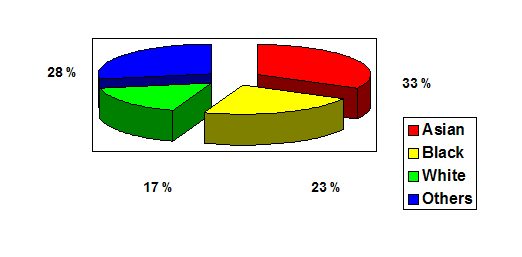
All the respondents are aware of CCTV cameras deployed in Newham but only 39 percent of respondents expressed that they are readily visible. Thus, without particularly seeking out the cameras, 61 percent said that they would not notice their presence. The cameras capturing an individual in Newham may be much lower compared with the general estimate of 300 cameras per person mentioned in other literatures. From the respondents, 21 percent (n = 25) noticed less than 30 cameras they passed through in a single day. However, the greater majority of respondents consisting of 75 percent (n = 90) passed more than 30 to 60 cameras everyday. A low 4 percent of respondents (n = 5) encounter 61 cameras and more as they walk through public spaces. The maximum of 90 cameras capturing a person in Newham in a single day represents 30 percent of the average pegged in UK (i.e. 300 cameras).
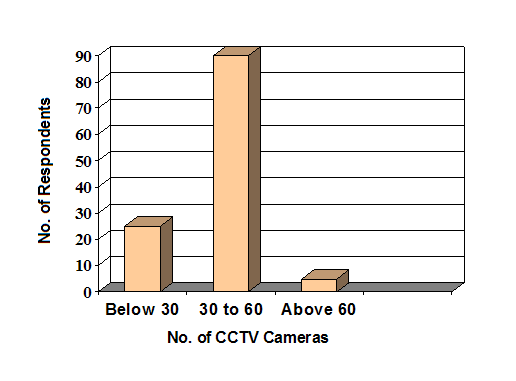
The respondents’ response on what they think is the purpose of the installation of CCTV cameras in public places can be grouped in three categories. One hundred percent of respondents said that it was for the safety lives and properties. On prevention of crime and violent behaviour, 50 percent of respondents expressed support for this view. Less than 20 percent believed that surveillance cameras are meant to monitor human activities and utilise the system to extort money from individuals who failed to follow traffic rules and regulations. The results implicate that residents of Newham are more inclined towards the positive viewpoint towards the program and system. No one expressed the opinion ensuing from the terroristic bombings that occurred around UK. Thus, the objective of curbing terrorism or apprehension of persons upholding such terrorism was not mentioned or even insinuated. Respondents focused more on the usual functions of law enforcement officers.
Charts 3 to 6 depict the respondents’ responses on the effectiveness of CCTV surveillance cameras in reducing crime based on gender and citizenship/non-citizenship, length of stay, ethnicity and age groups.
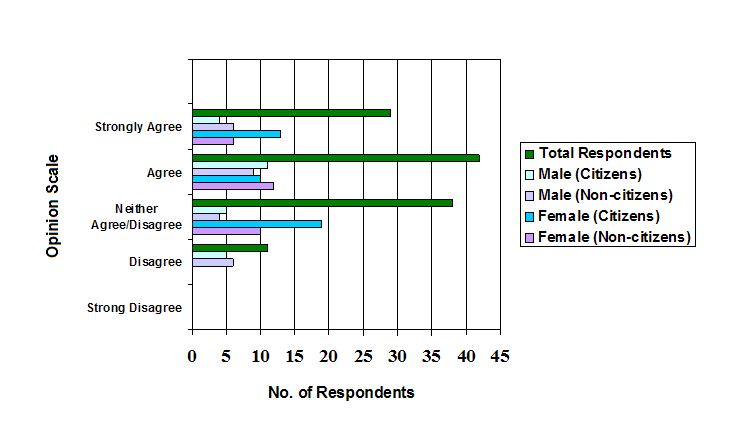
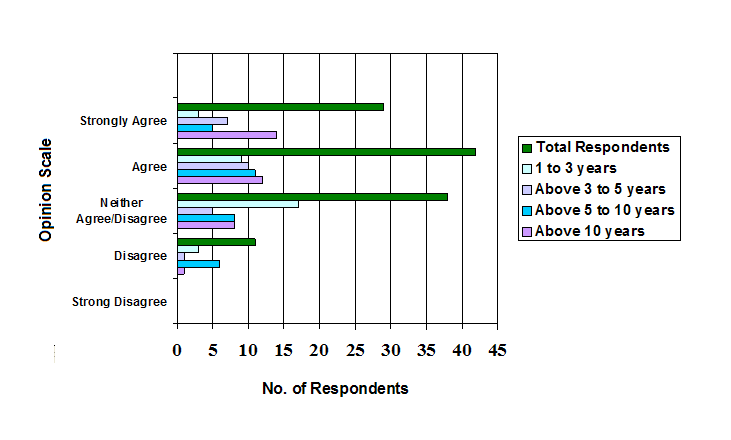
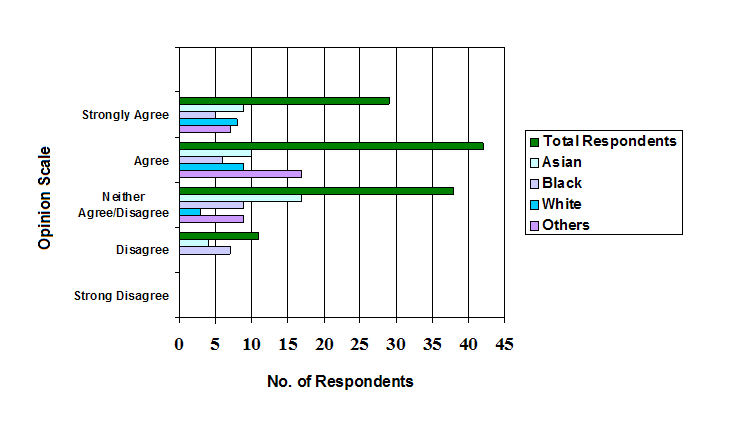

The following charts (Charts 7 to 10) depict whether respondents feel more secure with the presence of surveillance cameras based on gender and citizenship/non-citizenship, length of stay, ethnicity and age groups.
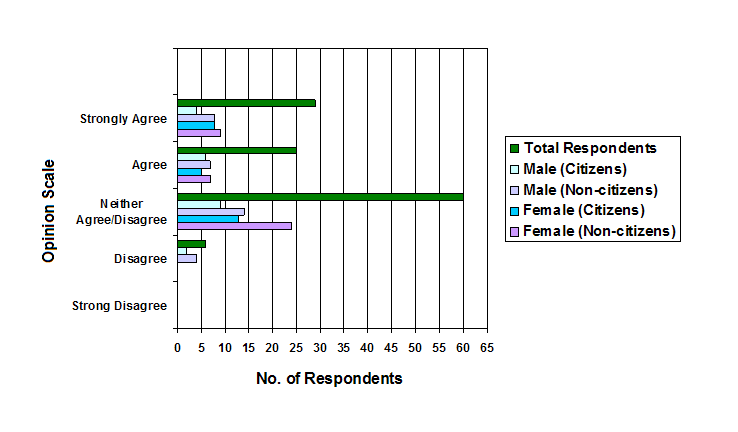
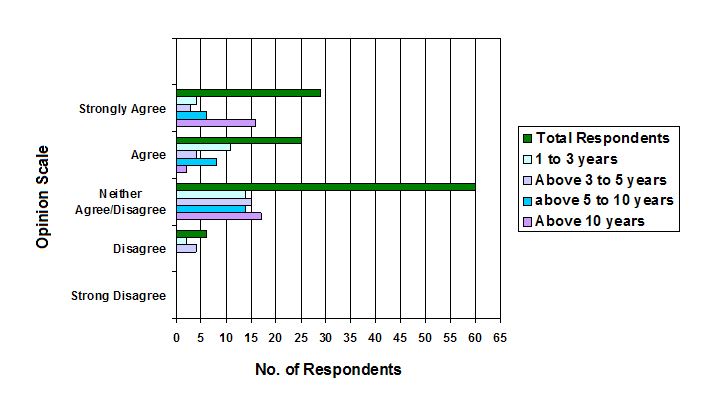
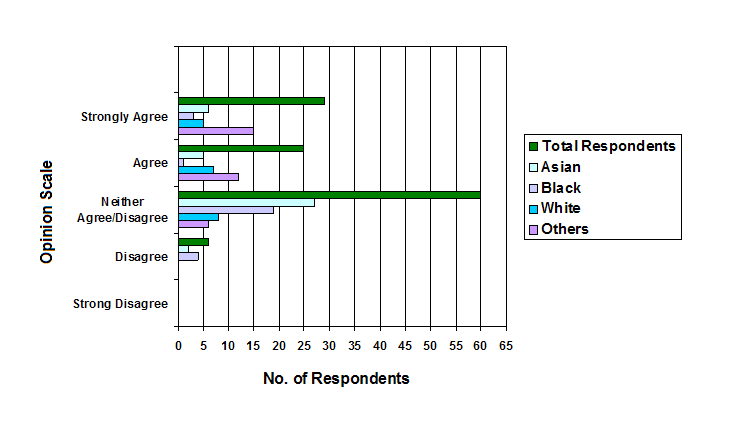
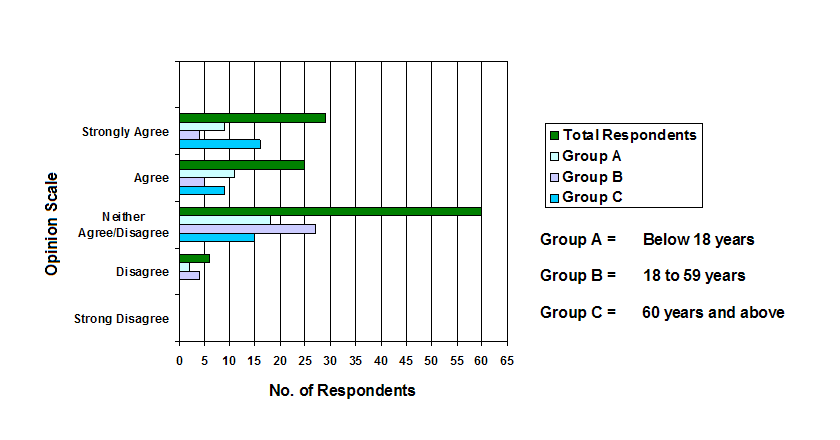
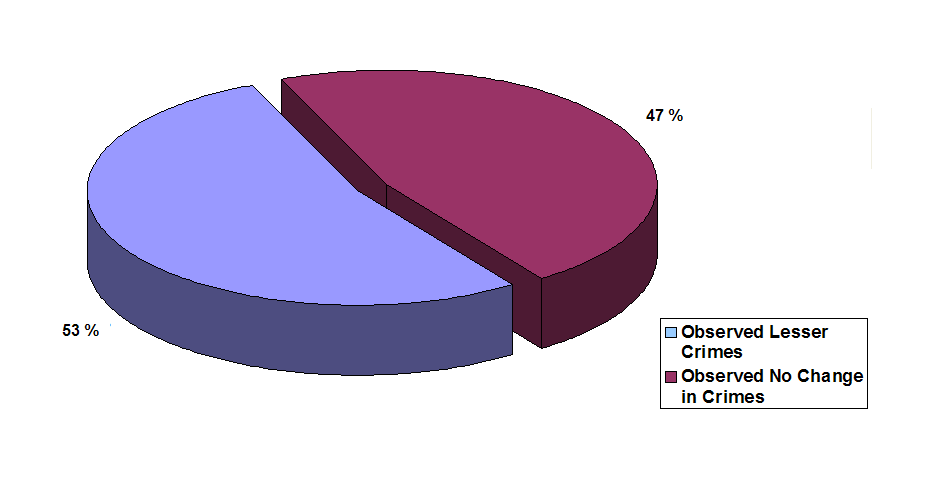
Not a single respondent provided an answer on the section asking the respondents their opinions on the implementation of CCTV surveillance against individuals. No one indicated that CCTV technology is an invasion of their privacy and violative of their civil liberties. All participants indicated awareness that many crimes were committed in the neighbourhood of Newham. Majority of respondents, 53 percent (n = 64), signified that CCTV technology resulted to lesser, which data is in congruence with result that 93 percent (n = 112) do not agree that CCTV surveillance cameras be removed in public places.
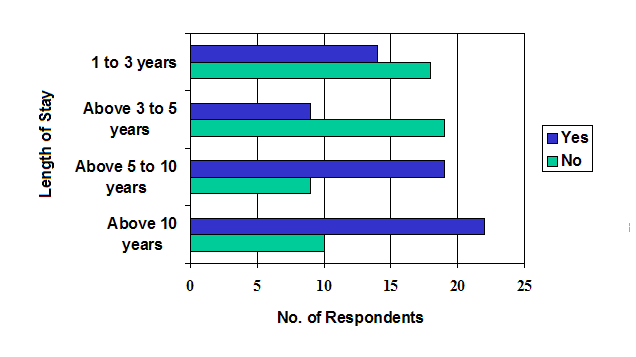
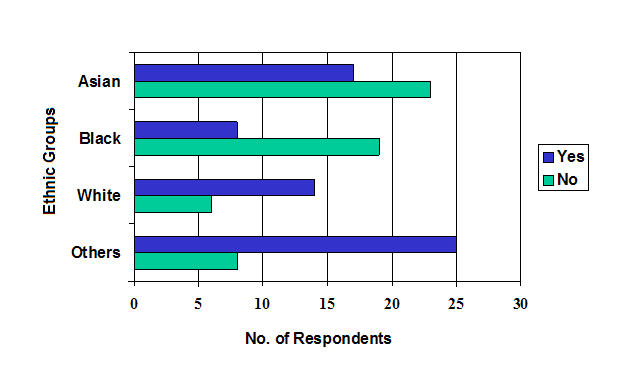
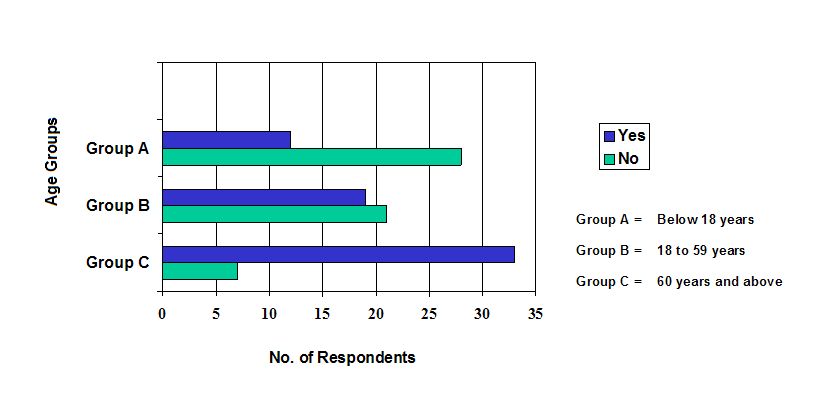
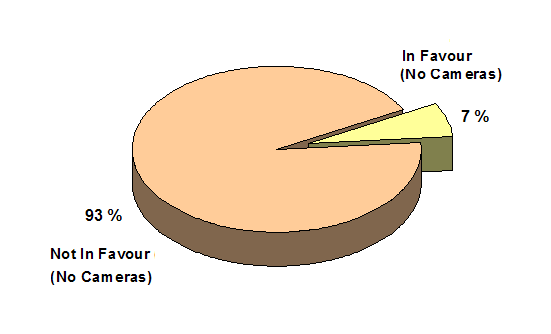
Based on the length of stay, ethnicity or age groups, the respondents are all in support of the presence of CCTV cameras in public places. It is an indication that this social group (as residents) is not in opposition with the government agenda on the use of CCTV technology upon them.
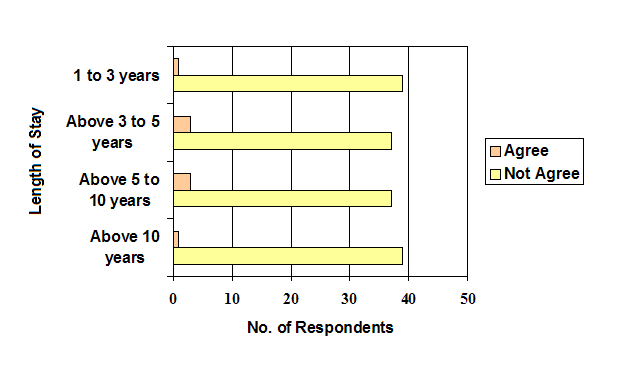
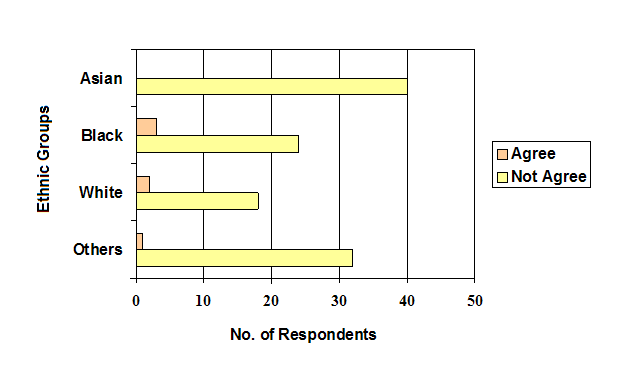
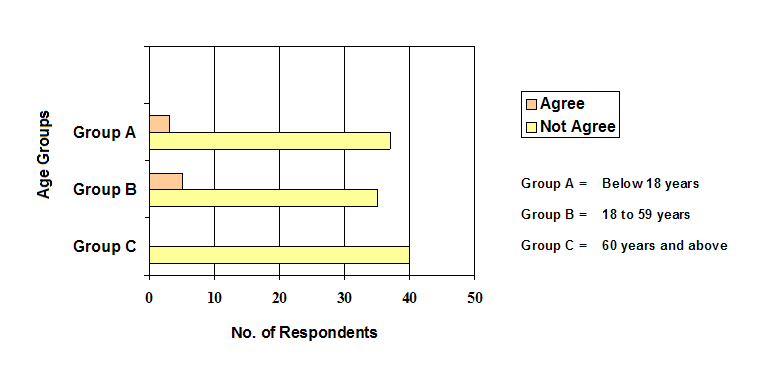
The greater number of respondents who observed a decrease in crime after the installation of CCTV cameras stayed in UK for more than 10 years (n = 22), belong to the ethnic category of “others” (n = 25), and Age Group C (n = 33). Most of those who did not observe a decrease have stayed in UK more than 3 years to 5 years (n = 19) and followed by those who lived from one to 3 years (n = 18), Asians (n = 23), and belong to Age Group A (n = 28). It is apparent that those who stayed from one to 5 years have seen the same crime rates because they lived in Newham after the installation of the cameras. Age Group C observed change in crime rates than Age Group A that belongs to the younger generation.
On the Questionnaire section on Effect of CCTV Surveillance that utilised the Likert/Opinion Scale, five scales were provided to respondents with the following values: strongly agree, 5; agree, 4; neither agree nor disagree, 3; disagree, 2; and strongly disagree, 1. Two questions were posed in the Opinion Scale: the first is “Have you observed lesser crimes committed in this borough after the CCTV surveillance cameras were installed?” and the second is “Would you prefer that there are no CCTV surveillance cameras in public places?” On whether CCTV surveillance cameras in public spaces are effective in reducing crime, the greater 35 percent of respondents (n = 42) believed to be so. It was followed by neutral respondents with 32 percent (n = 38). Only 24 percent of respondents (n = 29) strongly believed on the effectiveness of CCTV surveillance in crime reduction.
Table 7. Response on Crime Reduction and Security
It is noteworthy that 50 percent of respondents (n = 60) has no decision whether they feel secure with CCTV cameras around to monitor criminality. Only 24 percent (n = 29) expressed strong agreement that CCTV surveillance cameras in public places made them more secure. The response rate for both questions are just above the middle value of 3, indicating low appreciation for CCTV surveillance cameras in terms of crime reduction and security of Newham residents.
Discussion
Newham borough used smart CCTV capable of recognising facial features since 1998, indicating a digitalised technology. In 2008, it has initiated the transition of IP surveillance. Although Bob Lack’s assessment, as a former police officer and security manager, of a drastic decrease in crime in 15 years after the deployment of CCTV cameras, crime statistics in Newham from 2003 to 2008 indicated increase for two times as against the London rates which were on the downtrend. These data represent the period of time after the integration of facial recognition.
The survey results indicated that respondents favour the presence CCTV surveillance cameras in public spaces. Majority observed lesser crimes when this technology was used to fight crimes and a greater number preferred to have surveillance cameras in public areas. But whether they feel secure with surveillance cameras around, 50 percent of respondents neither agree nor disagree. Less than 25 percent “strongly agrees” and still lesser who “agrees” that they feel secure. Thus, the opinion of respondents on the effectiveness of CCTV surveillance in crime reduction cannot be equated and not proportional with their feeling of security. However, the observation of respondents who subscribed to CCTV technology’s effectiveness in reducing crime may not reflect the actual statistics (see Newham Crime Statistics from 2003 to 2008).
The efficiency of a technology and its application cannot be assessed merely based on the agenda of the implementer or the government. Its overall success must include all the social groups and entities in society. Assuming that the government succeeded in fighting crime through CCTV technology, there must be commensurate social, psychological, economic and political advantages to the people and society.
Under the Social Construction theory, in the process of attaining technological stability, there would be disagreements and tensions among the elements the involved in the system. This conflict is manifested in the advocacy of civic groups against violation of civil rights and liberties by the government. Scholars, academicians and researches contribute to the academic discussion through their intellectual discourses, supported by empirical researches and data, that increments the literary material on the technological device. The courts define the laws and rights of the people in relation to the technology and its effect upon the people and society. There is also the ICO that monitor the users, both private and government, on the information they collect and the purpose of such collection. The success of CCTV technology cannot be seen only through the components of this artifact but its effects and relationship with the people, social groups, social structure, governmental entities, laws and society. The Panopticon surveillance (analysed under the theoretical underpinning of Social Construction) and CCTV surveillance, although differentiate by some writers, is becoming the same with the increasing interconnection of various databases with the integration of newer technologies with the CCTV technology. Through interconnection, the future may see one Panopticon “tower” that can view all the information gathered on individuals.
Social Construction is an effective theory in analysing the interaction of the forces (including the technological artifact) within society. It is also effective in providing the rationale for the low crime reduction and differences in results in various crimes within the same location by considering the type of crime, the area being surveilled, and the human-technology interaction (e.g. response by law enforcers after operators viewed suspicious incidents). The response problem can be solved by proper coordination and enhancement of technology and software (e.g. automatic alarm in the police station after the system confirmed an incident and confirmed by operator).
How the Results Can Be Interpreted within Theoretical Framework
The proliferation of CCTV surveillance cameras is in congruence with the government program of reducing crime in all its legal classifications. Enhancement of the program followed the terroristic bombings that claimed the lives of innocent victims. This move by the government was done unilaterally without the necessary consultation with the stakeholders. To ensure the participation of the local councils, the national government provided the necessary funding for the infrastructure.
Several studies were already conducted in the United Kingdom to determine the efficacy of CCTV surveillance in reducing crime. The studies were made in various areas of the country both by the Home Office and researchers and scholars. However, a rationale conclusion cannot be reached the as results seemed to be erratic. In the same location covered by CCTV surveillance, statistics for one type of crime is decreasing while another type is increasing. On the other hand, one type of crime dropped for an unmonitored area while the monitored area increased. Thus, surveillance maybe effective for one type of crime but not for another even if conducted in the same location. Many authors have expressed the conclusion that CCTV surveillance does not really reduce crime. In this sense, the objective of the program was not achieved by the application of CCTV usage.
Using the constructivist perspective, the government as a social group, applied information technology to transform society to become safe for its inhabitants. But after several decades of utilising the CCTV surveillance system as an intervention mechanism, the commission of crime continued even in monitored areas. None of the studies yielded a zero crime rate.
Society shapes technology and decides which technology to develop that would embody the values and beliefs of the members. The values in a society should include the ideas, beliefs and norms of the various social groups in society. But when the government decided to apply CCTV surveillance as a crime intervention, it unilaterally embarked on the program without consultation with all stakeholders in society. In this sense, social construction is done by the dominant social group or social force, represented by the government. Since the constructivist theory allows a feedback mechanism wherein other groups in society provide input on the usage or application of technology, civil society groups, organisations, scholars and concerned citizens express apprehension over the use of technology that impinges upon people’s lives, privacy and freedom. They call on the government for the passage of more legislation that would guarantee the rights the liberties of the people. Privacy international and the Office of the Information Commissioner are agencies that represent the people’s voice over rights and liberties violation.
Society influences which technology to use in crime reduction that would embody their values. There should be a continuous interplay of groups and forces within society to achieve the best technology that society would use. On the part of the government, it continually seeks new technologies that can be used in the CCTV system. Technological engineers, on the other hand, continually search and research on the possible enhancements on the current technological artifacts already in use. Thus, developments in the CCTV system can be seen in the transformation from analog to digital to IP-Surveillance. The government, in the same manner, adapts the best technological artifacts available and integrate them into the system in the hope of making monitoring, recording and storage easier and ultimately, reduce crime in society.
The Newham Council aims to continue and upgrade CCTV surveillance to more sophisticated technology in the name of environmental protection and public safety (Newham borough 2008). While there is no mention of increasing the current number of more than 800 cameras deployed at various locations, the system is upgraded to attain to in-depth and intensive monitoring. This can result to greater loss of privacy and civil freedoms for innocent residents. Herein lies the need for balancing of interests as proposed by humanitarian advocates. It is proven time and again that any technology is prone to abuse by the authorities who control the system. Such abuse exists in the form of selling personal information by the law enforcers to private detectives as disclosed by the Information Commissioner (ICO 2006 May; ICO 2006 December, cited in PHR2206 2007).
While CCTV surveillance might be intimidating to Newham residents since they are monitored by personnel whom they do not know and the images are stored, a great majority of respondents believe that the objective of suon ch a program makes them more secure. But is it justifiable to monitor individuals who have not done any wrongdoing. CCTV surveillance program has been the agenda of the government for a long time. Together with the installation of more cameras to cover every corner, new CCTV technology is being introduced.
Society may utilise technology can be utilised for positive or negative uses and it’s the effects of its implementation can only be known at some later time (Burton 1992). Krantzberg described technology “neither good, nor bad, nor neutral” and may have effects not originally envisioned (e.g. the pollution caused by the car and traffic congestion) (Burton 1992. p. 23). Studies on the impact of IT do not reflect the correct state since they focus more on users (Burton 1992).
Conclusion
The use of CCTV technology in fighting crime has not much impact despite the huge spending. Generally, the application of technology has not much impact upon crime. It can be concluded that, if the analysis is based on the cost-benefit paradigm, the money used for the infrastructure, operation and maintenance did not provide the total benefit commensurate with the expenditure. As evidence-collection tools, stored images may not be effective in court prosecution and recognition if the criminals covered their faces. Benefits may come in the form of less expenditure in fuel (less patrolling), savings from manpower and manhours, more apprehensions of criminals, much lower crime rates, complete elimination of some crimes, and social and psychological benefits. While Newham residents know that the CCTV cameras were meant for the protection of lives and property, less than a fourth “strongly agreed” that they are effective in reducing crime and less that half “agreed” on the same. Less than a fourth of the respondents “strongly agreed” and “agreed” that they are ore secure with the CCTV cameras around. Thus, only a fraction of respondents perceived that they received social benefits (e.g. can walk safely in the environment, appreciation of social institutions that includes the government and law enforcement agencies) and psychological benefits (e.g. peace of mind, feeling safe, changes in behavior with the presence of CCTV cameras).
Newham’s move to incorporate IP technology will enhance its surveillance system. The cameras that pans, zooms and tilts improve recognition while the alarm system with movement detection could increase the response rate. Improvement in crime reduction and deterrence are still to be seen as an effect of the improvement in the surveillance technology. A research on the effect of improvement in technology can be made to determine if enhancements have impact on crime reduction and deterrence. The study may include the quantity of cameras needed per area that may effectively reduce or eliminate crime.
Ethical concerns and violations of privacy and civil liberties can be offset by the implementation of more laws that would guarantee the rights of the people. The government should be the protector of the rights of the people. But the government itself promotes the distribution of personal information in support of its programs. Since government leadership approves of such programs, legislators should pass laws specifically addressing concerns about the distribution and lay down safeguards so that only specific information shall be distributed, the nature of distributed information shall be published for the public to know, and that unauthorized distribution shall be legally punished. The database of images should not be reviewed unless a crime is under investigation. In this way, images of innocent civilians will not be reviewed and no individual will be targeted for surveillance based merely on the images in the database but from evidence outside the images.
Attaining the desired number of residents posed a difficulty because not a few respondents expressed reservation at the initial invitation due to their personal values and convictions. Interviewing more government officers and agents was not attained due to their unavailability and schedule differences. Moreover, the lack of written materials on various theoretical frameworks discussing CCTV technology and surveillance likewise delimited the research for this discourse.
Through the SCOTs’ perspective, CCTV surveillance technology is seen as a constituent part of the whole system and interacts with the other elements. The ultimate impact of the technology cannot be known as disagreements and conflicts among the various elements continue, influencing the path that technology undertakes. Groups or organisations may push for the use of the technology according to their agenda. In Social Construction, the end-user may reject CCTV technology for any other reason. This rejection may be influenced by the groups within society who viewed such technology as ineffective or ethically and morally invasive according to the values, morals and norms of society.
Privacy International is currently at the forefront of protecting civil liberties and rights against incursions by the government. Other social groups and entities may emerge later, together civic-minded individuals, scholars and academicians. These forces may later push their intellectual and ethical agenda against CCTV surveillance that would force the government to abandon the program and technology altogether in fighting crime. On the other hand, technological engineers may develop more efficient and sophisticated surveillance artifacts in the future that would be cost-effective. The proven effectiveness of this new artifact will compete with the social groups for acceptance in society, and if it prevails, may be adopted by the government. The government, on the other hand, may seek a compromise with the other social groups through the passage by the Parliament of laws that would protect individual rights, just let it pursue with its surveillance program. More than a decade has passed since the implementation of CCTV surveillance, but the ultimate levelling off of the technology as influenced by social groups and society, in general, is yet to come. It may take 50 years or more to achieve this leveling off and knowing the final impact of CCTV surveillance technology upon crime and society.
Criticism against the system persists from all sides. But the government has to protect the people in the light of the recent global terrorism that occurred even on the British soil. Therefore CCTV surveillance should remain in the current law enforcement system and be enhanced while being maintained at lower costs. Technological engineers should therefore work in this line to produce highly effective artifacts that can be acquired and used at lower costs. At the same time, checks and balances should be installed, technologically and legally so that abuses on personal information stored should be hampered. Social groups within Newham and the whole British society should be vigilant in lobbying the British Parliament to enact more laws that would ensure the protection of the rights and civil liberties of the people. At the same time, they should ensure that the current laws already in place be enforced to the fullest by the government. There must be a balancing of the elements so that, while promoting the good of the people against the danger posed by crimes, the program would not trample upon the rights of innocent individuals. The government sees surveillance technology as a viable means to fight crime. It might justify the implementation of the program through the apprehension of some suspected terrorists and crimes, rather than waste innocent lives and properties.
There is no complete available crime statistics in Newham since the inception of its surveillance program and no comparative study before and after the installation of the CCTV surveillance system. Literature on Newham’s surveillance started with its use of smart CCTV (1998). It was not mentioned whether Newham used an analog system or its surveillance program started before 1998. Thus, crime statistics before and after the deployment of CCTV cameras can be a viable field for future analysis to determine the crime trends and impact of surveillance technology. Constraints in time and resources also delimited the researcher in undertaking this study at present. The number of respondents for the survey questionnaire may be increased in another study to determine if the results would be different with more respondents per age group.
Future research in the same field could tread on how to make insignificant crime rates more significant, why certain crimes increase despite the presence of surveillance cameras, and why CCTV cameras are effective on certain crimes and not on other crimes. Analysis of information technology and CCTV system in relation to crime can also be analysed through the lens of other theoretical perspectives by other researchers. Moreover, similar surveys either through interviews or questionnaires can be conducted on residents to verify the results of this current study. Interviews can also be made upon government officials, enforcers or operators to get how views on the effectiveness of CCTV system as a crime intervention approach.
Evaluation
CCTV surveillance is not as effective as the government foresees it to be in crime reduction. This is manifest not only in Newham but also in other areas around the United Kingdom. The apparent reduction in crime is not remarkable or significant. In this sense, the huge amount of money being poured into the infrastructure and its operation seemed to be not proportional with the desired results. The budget set for the maintenance and operation of the system remained high even if not increased. But the government surely would pursue this type of intervention and continually upgrade the system if new technology not yet conceived at present would emerge in the future. However, the emergence on newer technology (e.g., digitalisation) lessened the cost of putting up additional devices, networking, storage and retrieval. Since the operation and maintenance of the system might entail lesser cost in the future, any increase in the budget expenditure can be utilised to widening the coverage of areas being monitored.
The study in Newham borough is the first that elicited views of residents on CCT surveillance. While crime statistics in Newham is available on a limited coverage, there is a dearth of available research materials about Newham besides articles and news items that highlights the plan of the council regarding surveillance system. Therefore, the results and findings of this study is a valuable contribution on the study of the efficiency of CCTV surveillance in Newham. This paper effectively presents the statistical findings of studies in other locations that this technology has no general significant effect in crime reduction and affects only certain crimes. The noteworthy finding is the sense of security majority of Newham residents have with the presence of surveillance cameras. They believe that surveillance would increase the protection to their physical being and their properties.
The findings would be specifically useful to the officials of Newham since they inform the officials that surveillance is viewed by the people as essential in the peace and order program of the council. Incorporating the crime statistics in the study would provide Newham officials the opportunity to analyse the cause of increasing crime rates in monitored areas. For Newham officials, the findings would enable them to devise means to increase the efficiency of CCTV surveillance where statistics showed less impressive results so that the cost expenditure would be commensurate with the results. Law enforcers, they should create strategies to enhance their response mechanism and apprehensions, while operators should create methods to transmit alarms and images to law enforcers in the most relevant and fast way.
Bibliography
2005 mid-year population estimates; Full briefing 2006. Web.
About Newham n.d., Newham, 2008. Web.
About the ICO n.d., ICO, 2008. Web.
Beagle, J 2008, The evolution of CCTV surveillance, EzineArticles.com.
Bowcott, O 2008, CCTV boom has failed to slash crime, say police, guardian.co.uk.
Brey, P 1997, Philosophy of technology meets social constructivism, Society for Philosophy and Technology, vol. 2, no. 3-4. Web.
Brown, B 1995, CCTV in town centers: Three case studies, Police Research Group, Crime Detection and Prevention Series: Paper No. 68, London: Home Office Police Department. Web.
Burton, PF 1992, Information Technology and society: Implications for the information professions, Library Association Publishing Ltd, England.
Carter, R 1993, Information Technology, Made Simple, Butterworth-Heinemann Ltd, Oxford, England.
Cartome 2001 June 16, Theory of surveillance: The Panopticon, Source: Bentham, Jeremy Panopticon Letters, Bozovic, M, ed., London: Verso, 1995, pp. 29-95. Web.
Census 2001: Newham 2001, National Statistics.
Chandler, D 2000, Technological or Media Determinism.
Clarke, R 1987, Information Technology and dataveillance, This paper was published in Commun. ACM 31,5 (1988) 498-512, and re-published in C. Dunlop and R. Kling (Eds.), ‘Controversies in Computing’, Academic Press, 1991. Web.
Converting an analog CCTV system to IP-Surveillance n.d., White Paper, Axis Communications. Web.
Crime: FTI Indicators, Selected Area: Newham LB 2008, Newham Information Management System. Web.
Cutting, G. 2008, Michel Foucault, Stanford Encyclopedia of Philosophy.
Darker, I, Gale, A, Ward, W, Blechko, A & Purdy, K n.d., Light, camera, action, and arrest, Applied Vision Research center, Loughborough University.
Ditton, J 1999, The effect of closed circuit television cameras on recorded crime rates and public concern about crime in Glasgow, The Scottish Office Central Research Unit Main Findings, no. 30. Web.
Doyle, EF 1997, Essay on the social shaping of technology. Web.
Freedom of Information Act n.d., ICO. Web.
Gill, M & Spriggs, A 2005, Assessing the impact of CCTV, Home Office Research Study 292, Home Office Research, Development and Statistics Directorate. Web.
How we are being watched 2006, BBC News.
Jackson, MH, Poole, MS, & Kuhn, T 2001, The social construction of technology in studies of the workplace, To appear in the Handbook of New Media, edited by Lievrouw and Livingstone, Sage Publications. Web.
Johnson, B 2007, Surveillance system tracks faces on CCTV, guardian.co.uk.
Klein, HK & Kleinman, DL 2002, The Social Construction of Technology: Structural Considerations, Science, Technology, & Human Values, vol. 27 no. 1, pp. 28-52, Sage Publications. Web.
KovacsBurns K 2005, Non-experimental research designs.
London Borough of Newham n.d., Encyclopedia, NationMaster.com. Web.
Maps and travel n.d., Newham. Web.
McCahill, M & Norris, C 2002, Working Paper No. 2, Literature Review, On the Threshold to Urban Panopticon? Analyzing the Employment of CCTV in European Cities and Assessing its Social and Political Impacts, urban eye.
Myers, MD 1997, Qualitative research in information systems, MIS Quarterly (21:2), pp. 241-242. MISQ Discovery, archival version. Web.
Newham borough council upgrades to IP surveillance 2008, PRO security zone. Web.
Newham Council race equality scheme 2005-2008 n.d. Web.
Newham in the census – a Synopsis n.d., Newham. Web.
Notification under the Data Protection Act 1998 n.d., ICO. Web.
Oakly, E 2005, Michel Foucault: The Panopticon and Panopticism. Web.
PHR2206 – United Kingdom of Great Britain and Northern Ireland 2007, Privacy International. Web.
Producing data n.d., Statistical Literacy, University of Wollongong. Web.
Register of data controllers (n.d.), ICO. Web.
Roche, EM & Blaine, MJ (eds) 1996, Information technology, development and policy: theoretical perspectives and practical challenges, Avebury, Aldershot, England.
Rogerson, S 2002, Smart CCTV, IMIS, ETHIcol, Originally published as ETHIcol in the IMIS Journal, vol. 12, no. 1. Web.
Social construction of technology 2005, Encyclopedia, NationMaster.com. Web.
Soghoian, C 2008, U.K. turns CCTV, terrorism laws on pooping dogs. Web.
Statement on Closed Circuit Television (CCTC) Surveillance Devices 1995, Privacy International. Web.
Squires, P 2000, CCTV and crime reduction in Crawley: Follow-up study 2000 – An independent evaluation of the Crawley CCTV system, Health & Social Policy Research center, University of Brighton. Web.
The Basics n.d., ICO. Web.
The London Borough of Newham crime survey n.d., Robbery, Crime Reduction Toolkits. Web.
The Panopticon, Jeremy Bentham 2005, Urban Eyes.
Trochim, WMK 2006, Types of surveys, research methods, knowledge base.
Tyler, R 2006, UK is CCTV Capital. ukwatch.net. Web.
Types of questions 2008, Writing Guides, Survey Research, Colorado State University.
Underhill, W 2000, Big Ben or Big Brother?: Every breath they take, someone is watching the Brits. Funny thing; they don’t seem to care, Newsweek. Web.
Walonick, DS 2005, Elements of a research proposal and report, StatPac. Web.
Ways of approaching research: Quantitative Designs 1999. Web.
Welsh, BC & Farrington, DP 2002 , Crime prevention effects of closed circuit television: A systematic review, Home Office Research Study 252, Home Office Research, Development and Statistics Directorate. Web.
Williams, R & Edge, D 1996, What is Social Shaping of Technology? The introduction to paper The Social Shaping of Technology, appears in Research Policy vol. 25, pp. 856-899, the Research center for Social Science, technology. Web.
Sweet, W 2006, Jeremy Bentham (1748-1832), The Internet Encyclopedia of Philosophy.
What is qualitative research 2007, QSR International. Web.